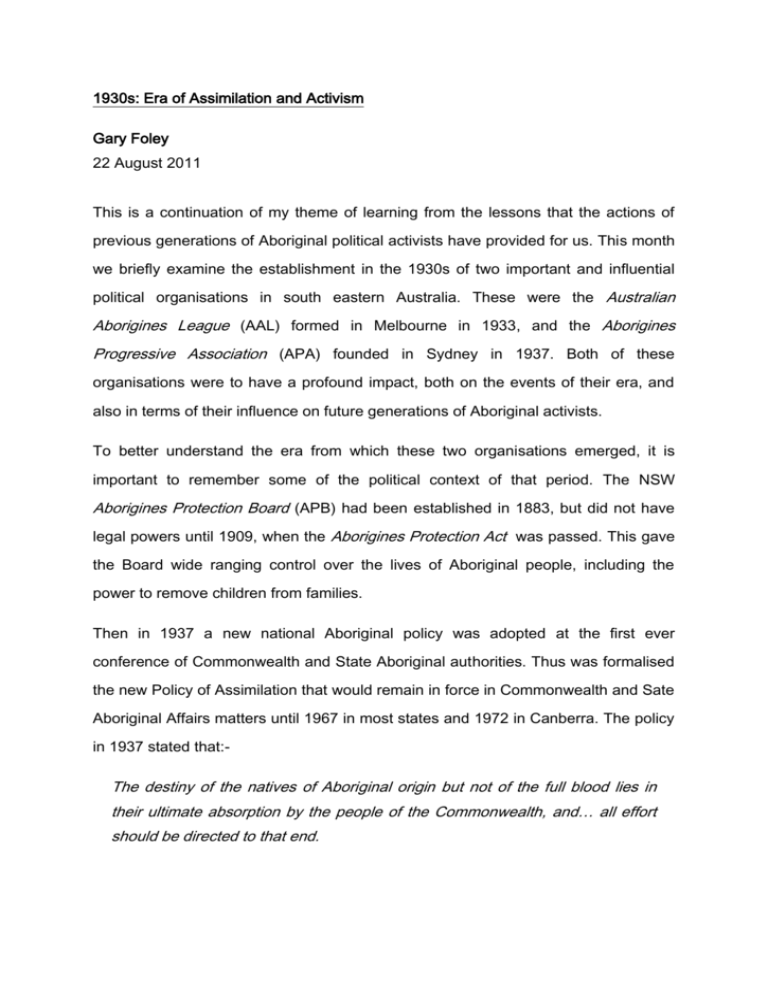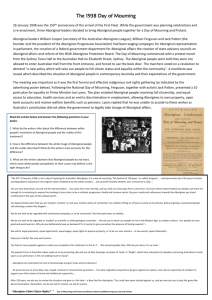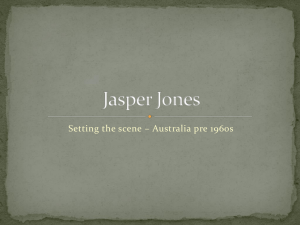newspaper 1930
advertisement

1930s: Era of Assimilation and Activism Gary Foley 22 August 2011 This is a continuation of my theme of learning from the lessons that the actions of previous generations of Aboriginal political activists have provided for us. This month we briefly examine the establishment in the 1930s of two important and influential political organisations in south eastern Australia. These were the Australian Aborigines League (AAL) formed in Melbourne in 1933, and the Aborigines Progressive Association (APA) founded in Sydney in 1937. Both of these organisations were to have a profound impact, both on the events of their era, and also in terms of their influence on future generations of Aboriginal activists. To better understand the era from which these two organisations emerged, it is important to remember some of the political context of that period. The NSW Aborigines Protection Board (APB) had been established in 1883, but did not have legal powers until 1909, when the Aborigines Protection Act was passed. This gave the Board wide ranging control over the lives of Aboriginal people, including the power to remove children from families. Then in 1937 a new national Aboriginal policy was adopted at the first ever conference of Commonwealth and State Aboriginal authorities. Thus was formalised the new Policy of Assimilation that would remain in force in Commonwealth and Sate Aboriginal Affairs matters until 1967 in most states and 1972 in Canberra. The policy in 1937 stated that:- The destiny of the natives of Aboriginal origin but not of the full blood lies in their ultimate absorption by the people of the Commonwealth, and… all effort should be directed to that end. 2 The policy of assimilation was to be imposed on Aboriginal peoples. They were not consulted in the development or implementation of the policy, and were consequently denied both their dignity and basic human right of self-determination. But worse would come as an insidious aspect of the grand social engineering project of assimilation would be the forced removal of children over the next several generations. The removal of children to have their “Aboriginal ways” indoctrinated out of them was thought to be the quickest way to achieve the process of assimilation. So it was in this political context that in 1933 the Australian Aborigines League (AAL) was formed in Melbourne by William Cooper, Marge Tucker, Shadrach James, Doug Nichols and other exiles from Cummeragunja. For most of the 1930s the AAL’s activities revolved around collecting signatures for a petition to King George V seeking direct representation in parliament, and basic civil rights for Aboriginal people. Meanwhile, in NSW Bill Ferguson, Pearl Gibbs and Jack Patten established the Aborigines Progressive Association (APA) in 1937 which agitated against the repressive NSW Aborigines Protection Board and also called for Aboriginal representation in Parliament. In 1938 Jack Patten published six issues of the first Aboriginal political newspaper, Abo Call. It described itself as "The Voice of the Aborigines" and was written by and edited by Patten and featured news gathered by him on his travels around Eastern Australia, and from correspondents nation-wide. The most significant moment for each of these organisations came in 1938 when they joined forces to organise a protest meeting in Sydney against the 105th Anniversary of white settlement. William Cooper had dubbed the 26 th January 1938 as a “Day of Mourning”, challenging the accepted white-Australian meaning of that day, which today continues to be a question that creates heated debate. The Day of Mourning protest in 1938 was significant because it was the first major, protest of the modern era that was noticed and recorded in the contemporary media reports 3 and history books. The fact that Australian embassies worldwide were briefed from Canberra about how to respond to questions about it from foreign governments show just how effective the 1938 protest was. At the end of 1938 in Melbourne, William Cooper, Doug Nichols Bill Onus and Marge Tucker were part of a deputation who sought entry to the German Consulate to present a petition on behalf of the AAL protesting against the Nazi German Government’s treatment of the Jews. The German Consul General refused to meet the deputation, but the incident illustrates the extraordinary political sophistication of Cooper and the rest of the deputation at that moment in history. This group of Aboriginal people were in fact the first in the Australian community to seek to protest about Hitler’s treatment of the Jews in Germany, ironically at a time in Australia when Nazi-style racial theories were popular and when the genocidal program of Assimilation was being enthusiastically implemented against Aboriginal people. The irony was obviously not lost on Cooper and his deputation as it is clear that they were seeking also to highlight the inherent similarities between the two countries, thus demonstrating a highly sophisticated level of international political awareness and acuity. The political activists of the 1930s developed their political awareness and organising skills on reserves like Cummeragunja under the oppressive yolk of the APB, and in the political hothouse camps of those evading the powers of the Board in such locations as Salt Pan Creek. They shared their knowledge and experience and cooked up new ways in which to challenge and confront the authorities of their day. From publishing a newspaper to mounting powerful symbolic protests such as the Day of Mourning and the challenge at the German-Consul General, this generation of activists inspired and set the example for the next generation that emerged in the 1950s. 4 Among the lessons we can learn from the heroes of the 1930s are the importance of communication of ideas and organising. Also, the raising of firstly your own political awareness, and then the political awareness of your fellow Aboriginal people. In my column next month I will look at the activists of the 1950s and 1960s and examine in which direction they then took the Aboriginal resistance, and what lessons we might draw from that era. Gary Foley








